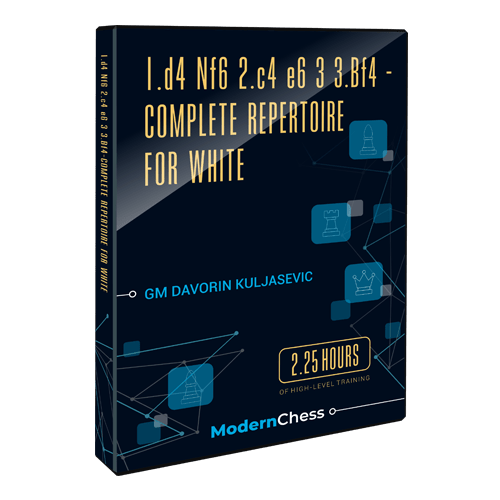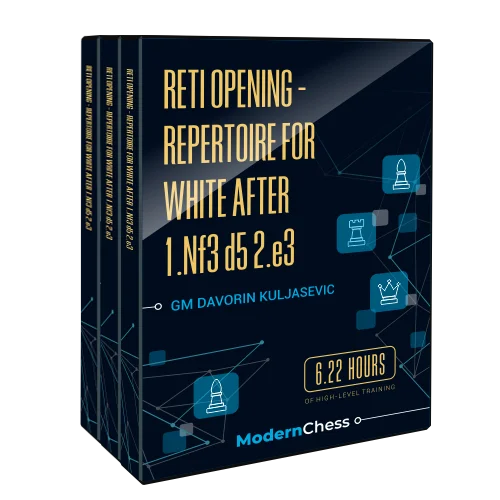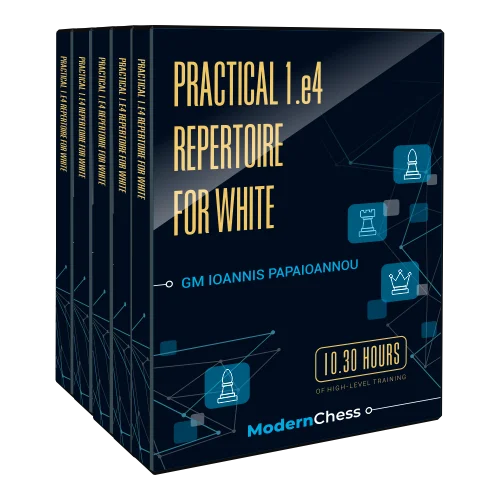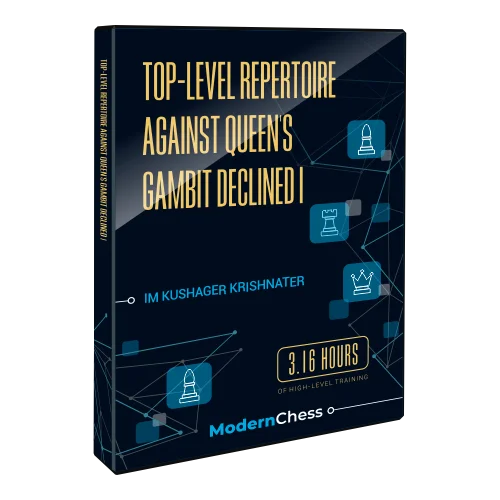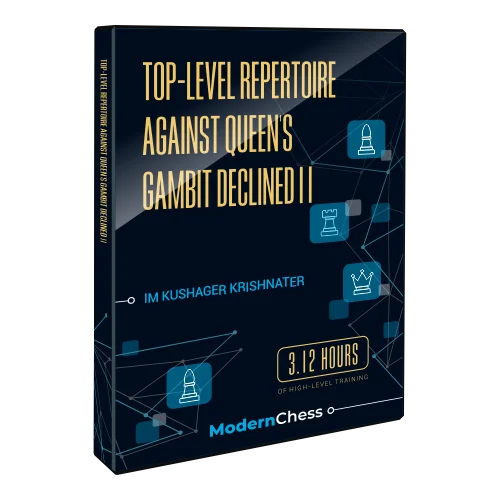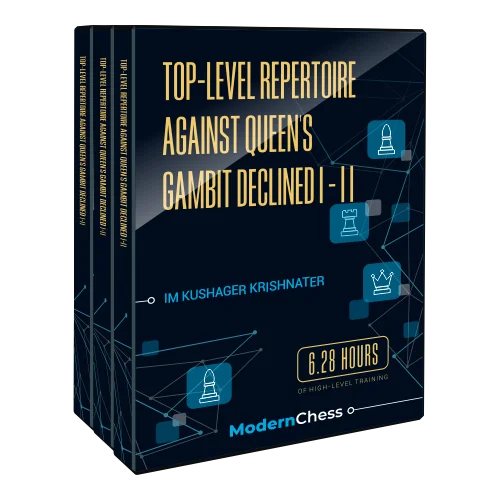The database consists of 8 theoretical chapters, 10 interactive test positions, a Video Version (2.5 Hours of Running Time), a Memory Booster, and Computer Practice.
Preview by the Author:
The starting position of the current database arises after 1.d4 Nf6 2.c4 e6 3.Bf4
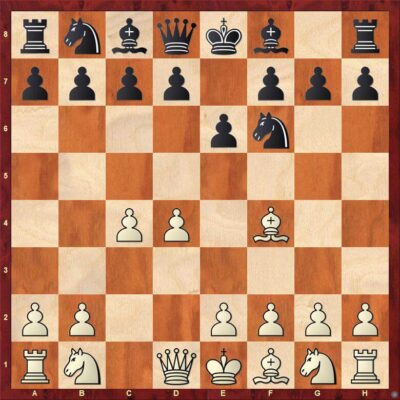
After the standard opening moves 1.d4 Nf6 2.c4 e6, White has a typical choice between 3.Nf3, 3.Nc3, and 3.g3. All three lead to big opening variations in which the theory branches deeply and widely. Sometimes white players avoid this early by playing 2.Bf4 (the London system), 2.Bg5 (the Trompowsky attack), or 2.Nc3 (the Veresov Attack), trying to get a less theoretical type of game. However, all these systems have a downside in that White usually delays or altogether omits to play c2-c4, which decreases his influence on the center.
That said, it might be possible to get the best of both worlds by playing 1.d4 Nf6 2.c4 e6 3.Bf4!?, a variation that has been largely unexplored throughout chess history. According to my database, the first strong players who played 3.Bf4 are Russian grandmasters Mozharov (in 2020) and Paravyan (in 2021). These were blitz games which they both lost as White, so one could have easily discounted this move as a failed experiment. However, soon after the World Champion himself, Magnus Carlsen, essayed this move in two rapid games in 2021 to score 2/2 against Wesley So and Levon Aronian! After that, other players took notice and this young variation has, tough somewhat shyly, taken off. So far, super-GMs Rapport, Duda, and Wojtaszek (twice!) have given it a go, as well as a couple of other grandmasters, basically testifying to its soundness.
In this database, I would like to present a full White repertoire based on this move that one can use as a sort of a secret weapon in their opening arsenal. In the remainder of this introduction, I will explain and provide:
1) the positional merits of this variation;
2) its practical aspects
3) the overview of the most important variations.
1) Positional merits: While it has to be admitted that all of the previously mentioned 3rd white moves seem more expedient than 3.Bf4 from a purely developmental point of view, this move is not at all unreasonable; as any experienced 1.d4 player knows, the bishop is successfully developed to f4 in a wide variety of opening variations in d4-systems. It often exerts pressure along the h2-b8 diagonal and facilitates the development of White’s queenside (Nc3/d2, Rc1, etc). White’s plan is typically to develop centrally (without the g3-fianchetto) with e3/e4 and Nf3/e2, really depending on what Black does. As we will see, the game very often transposes into some variety of a much better-known opening, such as QGD, the London system, Bogo-Indian, Nimzo-Indian, QID, Benoni, or Blumenfeld gambit. Most importantly, the analysis shows that White’s opening scheme is fundamentally sound in all cases.
2) Practical merits: As hinted in the introduction, the most important practical aspect of this variation is that it is likely to put the opponent outside of their well-known opening territory, and that counts for a lot these days. Secondly, it allows you, as the white player, to cut down on hours of opening preparation in the main lines of the Ragozin, Semi-Tarrasch, Nimzo-Indian, Queen’s-Indian, the Catalan, etc. Thirdly, it typically leads to positions that can be easily understood and played, even with limited experience with certain 1.d4 positions.
Yes, it will be important to remember a couple of key moves and variations to get the most from this variation, but these are minimal compared to the usual memorization work that one has to do in the main lines. Fourthly, this repertoire is quite appropriate for quicker time controls because it is more difficult for the opponent, especially a less prepared one, to solve his opening problems than in classical time control.
Finally, let me say that this variation is not a panacea – if Black plays the opening well, particularly in the QGD and Bogo/Nimzo setups, it is more likely that the game is headed for a level middlegame than not. White’s advantage in the critical lines is either minimal or we have a complex middlegame with roughly equal chances for both sides. However, if Black goes wrong somewhere, we have real chances to obtain an advantage. In this day and age, it is difficult to ask anything more from an opening variation. Now, let us see which options Black has at his disposal and what our general plan is against each of them.
The database consists of 8 theoretical chapters, 10 interactive test positions, a Video Version (2.5 Hours of Running Time), a Memory Booster, and Computer Practice.
Outline:
Chapter 1 – 3…d5 4.cxd5 exd5
Chapter 2 – 3…d5 4.cxd5 Nxd5 – Part 1
Chapter 3 – 3…d5 4.cxd5 Nxd5 – Part 2
Chapter 4 – 3…Bb4+ 4.Nd2 – Sidelines
Chapter 5 – 3…Bb4+ 4.Nd2 c5
Chapter 6 – 3…c5 4.d5 – Benoni Approach
Chapter 7 – 3…c5 4.d5 b5
Chapter 8 – 3…b6 and Minor Sidelines
Test Section
Computer Practice
About the Author:
GM Davorin Kuljasevic [FIDE 2591]
GM Davorin Kuljasevic is a Croatian GM, who graduated from Texas Tech University and played in USCL 2007 and 2008 for Dallas Destiny, becoming US champion both years. He is an experienced coach and a winner of many tournaments: Castelfranco Veneto 2014, Split Open 2013, Mitropa Cup 2013 with the team of Croatia, Lubbock Spice Cup Spring 2011, Rijeka Open 2011, etc.
